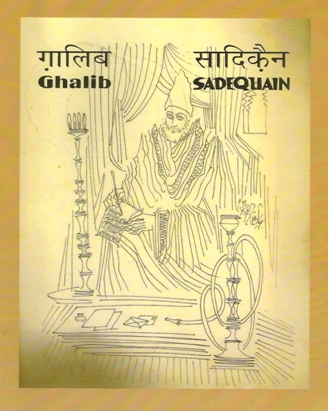 This book Ghalib and SADEQUAIN contains 25 verses of Ghalib, each inscribed in Urdu by Sadequain, along with their transliteration in Hindi. The corresponding paintings by Sadequain are shown on the opposite page of the text. Sadequain painted a total of 50 interpretations based on Ghalib’s poetry, but only 25 were located by the SADEQUAIN Foundation that are included in this book.
This book Ghalib and SADEQUAIN contains 25 verses of Ghalib, each inscribed in Urdu by Sadequain, along with their transliteration in Hindi. The corresponding paintings by Sadequain are shown on the opposite page of the text. Sadequain painted a total of 50 interpretations based on Ghalib’s poetry, but only 25 were located by the SADEQUAIN Foundation that are included in this book.
This visual journey through a blissful odyssey is an unadulterated experience of heightened awareness, as our senses process these mystic images and nurture our experiences for a meaningful life. These paintings reflect various states of self-realization and consciousness. When we are not in control of our intrinsic potentialities, they may stray off the course. But if we reach down and attain awareness of our innermost sentiments, then they manifest themselves in rapturous passion.
Ghalib is regarded as the most revered of Urdu poets. He composed poetry in Persian and Urdu, but he is most famous for his ghazals written in Urdu. Ghazal, arguably the most popular form of Urdu poetry, conforms to a specific format and in retrospect, predominantly deals with one subject: an expression of anguished and unattainable love. Ghalib, however, redefined its composition and imbued it with philosophical discourse, pondered on the mysteries of the universe and lamented about the travails of life. He composed ghazals to address many more subjects and vastly expanded the scope of the genre.
Ghalib’s ghazals have an influence of Sufi Mysticism, and therefore, the expression of love can either be interpreted as directed toward a higher being or for a mortal beloved. This expression, in either case, is intended to lift the believer to the ranks of the higher order and provide satisfaction to the soul. In keeping with the traditions of the classical ghazal, the gender of the beloved in most of Ghalib’s verses is elusive. It has thus been argued that his ghazals consist mostly of “sonnets about eternal love” in the traditional sense of the term.
In most cases, Ghalib’s ghazal is written from the point of view of the hopeless lover whose beloved is portrayed as unapproachable and unattainable. Most often, either the beloved does not reciprocate to the poet’s overtures with affection or responds with utter indifference. In other cases, social barriers would not be conducive for the love to bloom. However, the lover stays passionate; accepts his fate and continues to shower his affection. This tension of unattainable love provides the captivating impetus to the lyrics of the ghazal. To accentuate the intensity, sometimes the lover’s hopeless situation is portrayed even through poetically exaggerated violence, expressed by extended metaphors about the “arrows of his eyes” and by referring the beloved as a “callous assassin.”
In another form of deviation, Ghalib often digressed from the traditional ghazal metaphors and occasionally questioned old dogmas, which in Ghalib’s opinion, result in stagnation of critical thinking. His questioning of the existence of the heaven and hell would be one example of such digression.